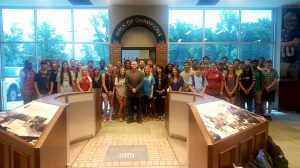
X2 Biosystems, NASA, C Spire, Cadence, UM Athletics and the University of Mississippi Medical Center have been getting help with complicated projects from University of Mississippi electrical engineering students. Submitted photo.
OXFORD, Miss. – University of Mississippi electrical engineering students are working with a range of corporate and governmental entities on several research projects in which the students offered engineering solutions to complicated real-world endeavors.
The team of UM students, led by Matthew Morrison, assistant professor of electrical engineering, has helped solve real engineering issues, just as experienced, full-time employees would, for X2 Biosystems, NASA, C Spire, Cadence, the Ole Miss Department of Intercollegiate Athletics and the University of Mississippi Medical Center.
The group has also helped mentor high school students who are interested in engineering careers.
“It’s really incredible to see how far they’ve come in terms of their professional development,” Morrison said. “Not only in terms of how much they are learning as engineers and scientists and completing a project, but also in terms of mentorship in terms of working with the high schoolers.
“They may have to convey an idea to someone who may not be a technical expert. They quickly learn this teaching thing is not as cut and dried as you would think it would be.”
The team worked with NASA’s Human Research Program to develop a method for sensing and detecting head impacts upon re-entry to Earth’s atmosphere from the International Space Station.
They also worked with C Spire and the Medical Center’s neurological intensive care unit to design a sleep-monitoring system for severe traumatic brain injury patients, and to convey data to nurses and doctors securely and reliably.
The athletics department and the Center for Health and Sports Performance used the team’s expertise on a design for a new water delivery system for practices for student athletes. The goal of the system is to reduce power consumption, while adding safety and reliability.
Cadence Design Systems used UM student engineers to integrate Cadence Internet Learning Services tools into the Department of Electrical Engineering’s new computer engineering curriculum.
The team has also worked with X2 Biosystems to develop a secure wireless protocol for low-power transmission of wireless sensor data. X2 makes the Head-Trax system, which is being used to monitor possible head injuries in athletes.
The system has been shown in multiple independent peer-reviewed studies to help significantly reduce the incidence and risks of head impacts and related injuries. “X-Patch” is a sensor by X2 that can be worn behind the ear to study cumulative brain damage from head impacts.
The companies got to see firsthand what the students can do with the training they’ve received at Ole Miss, Morrison said. Representatives of several companies and organizations that worked with the students were so impressed they wanted their resumes.
“They got to interact with them and help them improve their product,” Morrison said. “To be able to do that at a junior and senior level, that’s pretty rare.”
The students learned quickly that they aren’t just students, but also experts because they’re able to address obstacles to making a product or idea successful through engineering.
“All of these students had an ‘I belong’ moment,” Morrison said. “Their eyes get really big and they go, ‘Oh, I just had an idea that can help X2 Biosystems. Oh, I just had an idea that can help NASA.”
“That’s something they wouldn’t have even dreamed of nine weeks ago, and now they’re actually doing it and are able to run with it,” Morrison said. “They’re starting to grasp what an opportunity this is and how it is going to be able to help them in the future.”
Xavier Pittman, a senior electrical engineering major from Batesville, said getting the experience and adding to his resume means a lot to him, especially because he got to use new technology that isn’t available to most people. He was part of the team that worked with X2 Biosystems.
“It actually made me feel like I was an actual engineer and not just a student,” Pittman said. “Wow. I’m a skilled worker. I’m actually having to think about how I am going to solve this problem and having to use everything I’ve learned over all of these years and actually have the opportunity apply it.”
Pittman said he is thankful to be chosen for the program.
“I never imagined things like this would come up,” he said. “It’s amazing we have these opportunities here and they’re easily accessible. The instructors will reach out to you and give you these opportunities.”
Maisha Sadia, a senior electrical engineering major from Bangladesh, also worked on the X2 Biosystems project.
“It literally set the foundation for the company, so it was a big deal for us,” Sadia said. “We felt a little like superheroes. We did that for them. It is also amazing to know I could actually do that. I put in work for two months and we came up with that. It was a very cool feeling.”
The required presentations and public speaking, as well as a large dose of professional writing that was required helped Sadia develop her workforce skills. She has also enjoyed mentoring female high school students who want to become engineers.
She told the students about the confidence she’s gained by working with X2.
“(I told them,) you can do it, too,” Sadia said. “If you set your heart to it, you can be a superhero, too.”